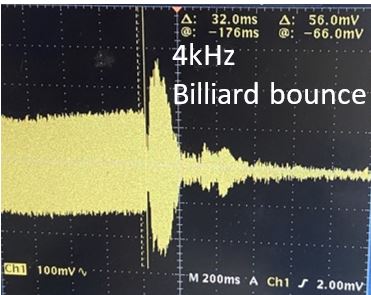Students in a physics class recently found themselves learning in an unlikely place: the basement of Mercer Music at Capricorn.
Down below the historic Capricorn Sound Studios, Mercer University students clustered around one of the small cinderblock rooms lined with ceramic tile. A microphone and a speaker were set up inside the room, known as a reverberation, or reverb, chamber.
“Back in the ’70s and in that era of Capricorn’s peak, we didn’t have all the fancy digital processing stuff that we have now to add reverb to music, and so it had to be done mechanically,” said Dr. Matt Marone, associate professor of physics in the College of Liberal Arts and Sciences. “And so, these reverb chambers were the way they did it.”
The method is still used at Capricorn today. Here’s how it works: The engineer in the control room sends a signal from the sound board down to the speaker in the reverb chamber. The speaker plays the audio, and the sound bounces off the tiles creating an echo, which is captured by the microphone and sent back up to the sound board.
The students were measuring the impulse response in one of the chambers — or how long the reverberation lasts for different frequencies. The class was also measuring the response for different speaker and microphone placements.
“The reverb time that you get depends on the frequency,” Dr. Marone said. “If you play music and then you let it reverberate or decay or die out, the different frequencies will die out at different rates, and that gives it like a fingerprint, a characteristic sound.
“So, these reverb chambers or tanks that they have here, they have their own special sound.”

The information will be shared with Capricorn’s chief engineer, Rob Evans, who may be able to use it when recording. The class is working in one of the reverb chambers that he’d like to start using more, and the data may be helpful in determining the position of the speaker and microphone, said Evans, who has a master’s degree in business from Mercer.
The students are taking PHY 102: Acoustical Foundations of Music. It’s a general education class for non-science majors and attracts students from programs across the University. The class, offered every two years, examines music and sound from a scientific point of view.
Other projects have included students making their own flutes out of polyvinyl chloride, or PVC; using sound level meters to measure various sounds across campus; and touring the University’s organ.
“The last lab that we did where we made our own flute was very fun. My flute doesn’t work because I made it wrong, but it was still very fun,” said Phillip Dekle, a senior majoring in psychology.
Elijah Smith, a freshman majoring in journalism, said his adviser assigned him to the class after he indicated music was one of his interests.
“It’s been fun, but it’s also a lot of work because it’s physics, so it’s also tough,” he said.

Smith said he’s a fan of progressive rock, so the class has been particularly interesting to him.
“It’s cool to learn about the mechanics, the science behind all the music,” he said.
The Capricorn project provides students with hands-on experience in a real-world setting, Dr. Marone said.
“We’re able to come up with something that is going to be useful in the studio’s recording, plus it helps the students have some real-world experience,” he said.










